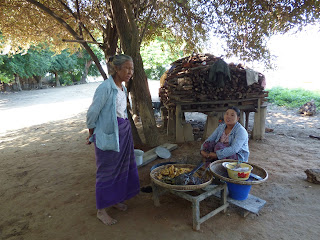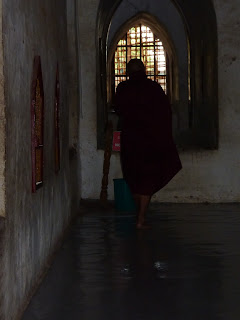As I reflect on my trip to Myanmar, sorting through photos, reminiscing, and trying to find the best words to describe the experience, I find myself a bit at a loss. This wasn’t just a trip; it was an immersion course in a history, culture, tradition, and religion that left me enriched, educated, grateful, and amazed, but also knowing that my life and who I am are worlds away from where I was and that there are still many unanswered questions.
I walked through villages that, by western standards, one could only describe as primitive, but where people were so proud to share their homes, where children ran around laughing and playing with sticks, and where students proudly went to local schools that lacked all, but the rudimentary basics.
Yandabo Village, where in 1826 the peace treaty was signed that ended the first Anglo-Burmese War. The economy today is based on making clay pots for villages on the river.
Each family has its own stamp to identify who made the pot.
Checking voter registration lists
Voter registration confirmation
Collecting palm sap in Shwe Pyi Thar Village
I was invited into homes in small towns where curtains divided the spaces in the one room lived in by several, where family photos were proudly hung on the walls, and where satellite dishes were attached to the rooftops while the bathroom was outside.
I toured cities with historical palaces and tree-lined streets, with congested traffic and crowds of people, with men and women wearing longyis as well as western clothing, and with monks in red robes whose presence everywhere is respected and fundamental to the core of this country.
I learned about Buddhism and saw thousands of statues of the Buddha in all shapes and sizes and people, no matter where, taking time to pay homage and pray.
Semi-circular temple of the U Min Thonse Pagoda in Sagaing where 30 caves hold 45 Buddha statues, each representing a year of his teaching.
I visited monasteries and nunneries throughout the country where parents can bring their children for safe-keeping and education if they are not able to take care of them.
And I was in awe of the thousands of stupas and pagodas in the hills, on the roads, just about everywhere; a testimony to the deep faith of the people to a religion…to a way of life.






















































So many questions... how is a people so materially poor able to support such a religious presence? There is such an important place in their lives for beauty, simplicity, and hospitality, I wonder if the presence of tv and the like threatens to change all that? Thank you for sharing this exeperience!
ReplyDeleteSo many questions... how is a people so materially poor able to support such a religious presence? There is such an important place in their lives for beauty, simplicity, and hospitality, I wonder if the presence of tv and the like threatens to change all that? Thank you for sharing this exeperience!
ReplyDelete